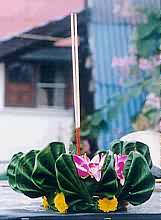Loi Kratong festival
The Loy Krathong ceremony is held every year on the full moon of the 12th month in the traditional Thai lunar calendar. Which is also known as Yi Peng in the north, is the most colorful festival of the year. It takes place over three days of the full moon of the twelfth lunar month, which is usually in November. The festival may have evolved from Brahmanic rites to honor the dead as well as local rites to bring an end to the rains.
"Loy" means "to float" and "krathong" is a raft traditionally made from part of a banana tree trunk. Sometimes these rafts are made of bread as it protects the environment. The raft is decorated with banana leaves, flowers, candles, incense sticks etc. The Thai people set the raft afloat to honor and pay respect to the goddess of water. Also, they apologize to the goddess of water for any bad things they have done to the river during the past year.
Though legends suggest it was established by the time of King Tilokarat in the late 15th century, the origins of this festival prior to the 19th century are uncertain.
 Now people generally believe that by releasing floats and balloons they get rid of bad luck and give thanks to the water and heavenly elements. Older folks may say that it is to show gratitude to the Goddess of the River - Mae Khong Kha - for use of the water.
Now people generally believe that by releasing floats and balloons they get rid of bad luck and give thanks to the water and heavenly elements. Older folks may say that it is to show gratitude to the Goddess of the River - Mae Khong Kha - for use of the water.For the three nights of the festival people release small floats - Kratong - made of disks cut from the banana tree stem and banana leafs, with offerings that include incense, flowers, candles and money into the rivers and lakes. The Ping River becomes a stream of lights floating gently with the current. Small hot air balloons rise like lanterns high into the sky, complementing the floats drifting on the waters. Fireworks are let of everywhere, particularly on the banks of the Ping River, and there is a parade each night in Chiang Mai.
The festival begins the day before the full moon. People decorate the entrances of there houses with coconut branches, banana leafs, sugar-cane lanterns and colored paper. As dusk falls people light earthen lamps placed along the walls of their property and the fireworks start. The lantern parade takes place on Wang Sing Kham Road between Nawarat Bridge and Nakhorn Ping Bridge.
On the morning of the day of the full moon, people present offerings at the temples before releasing large hot air balloons from temple grounds. A competition for the best balloon is held in front of Chiang Mai Hall on Wang Sing Kham Road. Boat races are held on the river.
Tips
* Now flying ballon are very popular on Loy kratong festival night before only release flying
ballon in the temple and flying ballon are made by monk because we believe that all bad things will go with flying ballon.
* After Loykratong parade you can joy kratong floating at Ping river if you do not have kratong you can buy from that area.
| Songkran Festival in ChiangMai 2011 |
This festival marks the traditional Thai New Year, which until 1940 used to be when the Siamese new year began. The festival is the most important and is traditionally held when the sun moves out of Pisces.
In Chiang Mai the main events take place over three days (the dates vary for other northern provinces). By custom the first day falls on April 13th and is the last day of the old year.
In the morning people will clean their houses. In the afternoon a parade of Buddha images from Chiang Mai temples goes from the railway station to Wat Phra Singh. Northern people toss lustral water (water scented with perfume and flowers) to bathe the images as they pass along the streets. The Phra Sihing image leads the procession to Wat Phra Singh, where it is set in front of the temple for citizens to bathe throughout the rest of the festival.
Ceremonies are not held on the second day, which separates the new year from the old. In the afternoon sand is placed in the temple compound as a symbolic return of the sand carried out on the soles of shoes and feet of the people. The sand is made into small stupas for the next day.
The new year begins on the third day. The early morning is a particularly good time to visit the temples to watch people in traditional costume bringing offerings.
Ceremonies are held in the viharn. Outside, the people place flags in the sand chedi as well as symbolic sticks of support under Bhodi trees to bring good fortune in the new year.
Later in the day juniors pay respect to senior people and family members in a ceremony known as tam hua. In the afternoon the main government organizations hold a procession from Yupparat School to honor the governor at his residence by the Nawarat Bridge.

